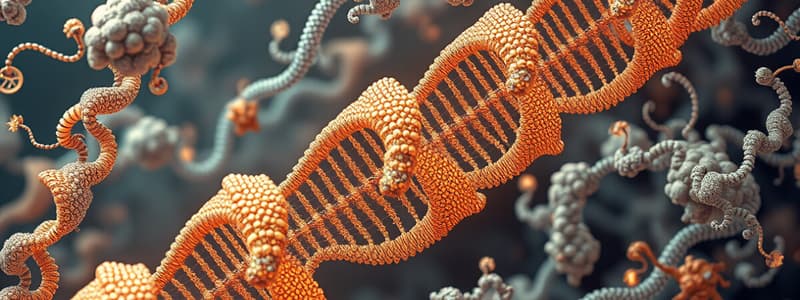Podcast
Questions and Answers
What is the process by which a sequence of nucleic acids in RNA is used to direct the production of a chain of specific amino acids?
What is the process by which a sequence of nucleic acids in RNA is used to direct the production of a chain of specific amino acids?
- Replication
- Protein synthesis
- Translation (correct)
- Transcription
What is the term for the process whereby DNA makes a copy of itself before cell division?
What is the term for the process whereby DNA makes a copy of itself before cell division?
- Codon
- Transcription
- Translation
- Replication (correct)
The organic process whereby the DNA sequence in a gene is copied into mRNA is called?
The organic process whereby the DNA sequence in a gene is copied into mRNA is called?
- Replication
- Transcription (correct)
- Protein synthesis
- Translation
What is uracil?
What is uracil?
What does mRNA stand for?
What does mRNA stand for?
What does tRNA do?
What does tRNA do?
What is rRNA's role?
What is rRNA's role?
Where are proteins made?
Where are proteins made?
What is a codon?
What is a codon?
What are amino acids?
What are amino acids?
What is protein synthesis?
What is protein synthesis?
What are nitrogen bases?
What are nitrogen bases?
What is a nucleotide?
What is a nucleotide?
What is ribose sugar?
What is ribose sugar?
What is deoxyribose sugar?
What is deoxyribose sugar?
What is guanine?
What is guanine?
What is cytosine?
What is cytosine?
What is thymine?
What is thymine?
What is adenine?
What is adenine?
What is AUG?
What is AUG?
What is UAA?
What is UAA?
Flashcards
Translation
Translation
The process of converting RNA sequences into amino acid chains, essential for protein synthesis.
Replication
Replication
The process by which DNA copies itself before cell division, ensuring the genetic material is passed on.
Transcription
Transcription
The process of copying DNA sequences into mRNA, a key step in protein production.
Uracil
Uracil
Signup and view all the flashcards
mRNA
mRNA
Signup and view all the flashcards
tRNA
tRNA
Signup and view all the flashcards
rRNA
rRNA
Signup and view all the flashcards
Ribosomes
Ribosomes
Signup and view all the flashcards
Codon
Codon
Signup and view all the flashcards
Amino Acid
Amino Acid
Signup and view all the flashcards
Protein Synthesis
Protein Synthesis
Signup and view all the flashcards
Nitrogen Bases
Nitrogen Bases
Signup and view all the flashcards
Nucleotide
Nucleotide
Signup and view all the flashcards
Ribose Sugar
Ribose Sugar
Signup and view all the flashcards
Deoxyribose Sugar
Deoxyribose Sugar
Signup and view all the flashcards
Guanine
Guanine
Signup and view all the flashcards
Cytosine
Cytosine
Signup and view all the flashcards
Thymine
Thymine
Signup and view all the flashcards
Adenine
Adenine
Signup and view all the flashcards
AUG
AUG
Signup and view all the flashcards
UAA
UAA
Signup and view all the flashcards
Study Notes
Translation
- Translates RNA nucleic acid sequences into chains of specific amino acids.
- Essential in the process of protein synthesis.
Replication
- DNA self-copies prior to cell division.
- Ensures genetic material is passed on during cell reproduction.
Transcription
- Copies DNA sequences in genes to make mRNA.
- Key step in transferring genetic information for protein production.
Uracil
- RNA nucleotide that replaces thymine found in DNA.
- Pairs with adenine during RNA processes.
mRNA (Messenger RNA)
- Carries genetic information from DNA in the nucleus to ribosomes.
- Acts as a template for protein synthesis.
tRNA (Transfer RNA)
- Delivers amino acids to ribosomes during protein synthesis.
- Helps translate the mRNA codons into amino acid sequences.
rRNA (Ribosomal RNA)
- Component of ribosomes that binds to mRNA.
- Facilitates assembly of amino acids in the correct sequence.
Ribosomes
- Sites of protein synthesis in the cell.
- Composed of rRNA and proteins.
Codon
- Triplet sequence of nucleotides on mRNA.
- Each codon codes for a specific amino acid.
Amino Acid
- Fundamental building blocks of proteins.
- Twenty different types combine to form various proteins.
Protein Synthesis
- Assembly of amino acids into proteins.
- Requires mRNA, tRNA, and ribosomes for completion.
Nitrogen Bases
- Components of the DNA ladder rungs: adenine (A), thymine (T), cytosine (C), guanine (G).
- A pairs with T and C pairs with G in DNA structure.
Nucleotide
- Subunit of nucleic acids composed of a sugar, phosphate group, and nitrogenous base.
- Key building block of RNA and DNA.
Ribose Sugar
- Sugar component of RNA, forming the backbone of the molecule.
- Contains one more oxygen atom than deoxyribose.
Deoxyribose Sugar
- Sugar component of DNA, forming its backbone.
- Lacks an oxygen atom compared to ribose sugar.
Guanine
- Purine nitrogen base found in both DNA and RNA.
- Pairs with cytosine during base pairing.
Cytosine
- Pyrimidine nitrogen base present in DNA and RNA.
- Pairs with guanine in base pairing.
Thymine
- Pyrimidine base present only in DNA.
- Pairs with adenine to stabilize the DNA structure.
Adenine
- Purine base in both DNA and RNA.
- Pairs with thymine in DNA and with uracil in RNA.
AUG
- Start codon that signals the beginning of protein synthesis.
- Initiates translation at the ribosome.
UAA
- Stop codon in mRNA that signals the end of protein synthesis.
- Also includes UGA and UAG as termination signals.
Studying That Suits You
Use AI to generate personalized quizzes and flashcards to suit your learning preferences.




